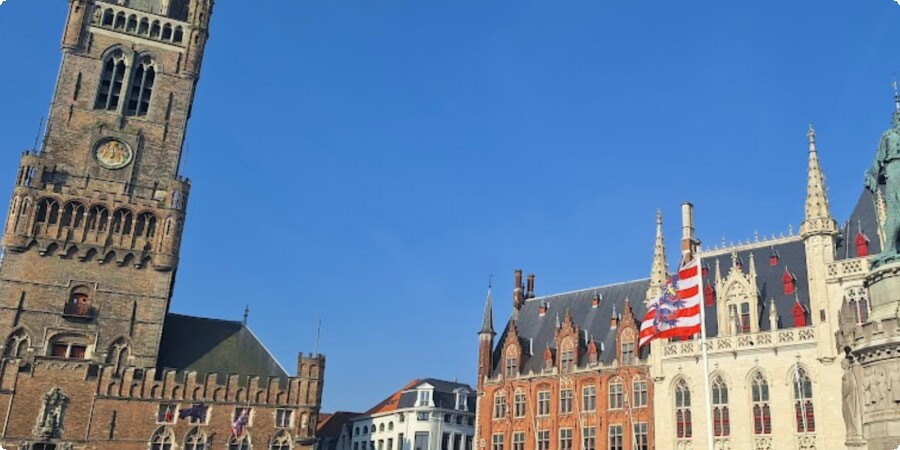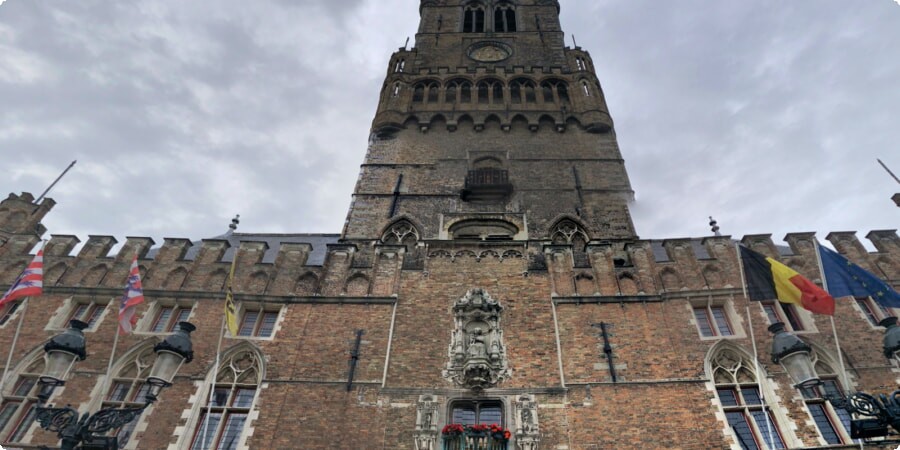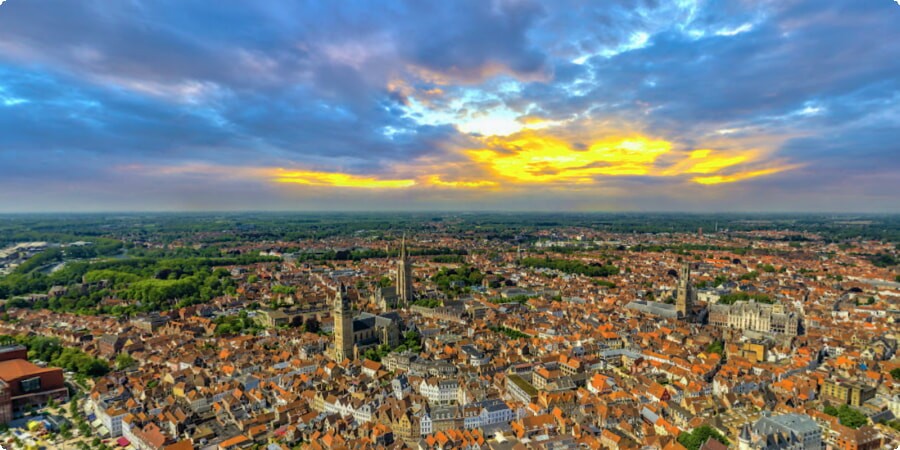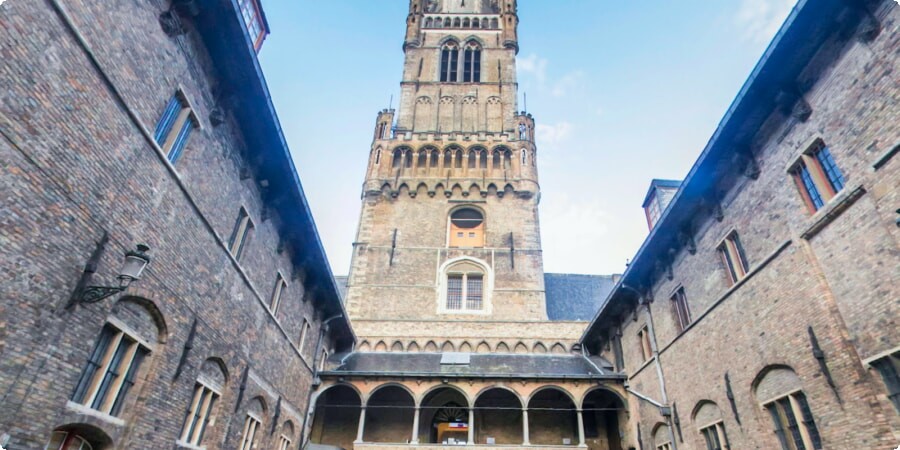Standing tall and proud in the heart of Bruges, the Belfort (Belfry) is an iconic symbol of the city’s rich history and cultural heritage. This medieval bell tower, which soars to a height of 83 meters, dominates the skyline and offers panoramic views of the picturesque town below. The Belfort is not just an architectural marvel; it is a testament to Bruges' historical significance and its enduring spirit.
Visitors to Bruges are often drawn to the Belfort, intrigued by its grandeur and the stories it holds. Whether you’re a history enthusiast, an architecture lover, or simply looking for the best vantage point in the city, the Belfort of Bruges promises an unforgettable experience.
Historical Background
The Belfort's history dates back to the 13th century, with the original wooden structure built in 1240. Tragically, this first tower was destroyed by a fire in 1280, leading to the construction of the current stone structure. Over the centuries, the Belfort has witnessed numerous significant events, including Bruges' golden age during the medieval period when the city was a bustling hub of trade and commerce.
One of the most fascinating aspects of the Belfort is its role in the city's economic life. The tower housed the city’s treasury and served as a lookout post for spotting fires and other dangers. Its bells played a crucial role in regulating daily life, signaling market hours, and important events.
For those interested in diving deeper into the Belfort's rich history, Wikipedia provides a detailed account of its evolution and significance.
Architectural Features
The Belfort of Bruges is a masterpiece of medieval architecture, combining both functional and aesthetic elements. The tower's striking facade is adorned with intricate stonework and statues, reflecting the Gothic style that was prevalent during its construction. The octagonal upper stage, added in the late 15th century, gives the tower its distinctive silhouette.
As you approach the Belfort, you'll notice the ornate entrance and the statues of the Madonna and Child, which were added in the 19th century as part of restoration efforts. Inside, the Belfort features a narrow, winding staircase with 366 steps that lead to the top. Along the way, you'll encounter various rooms, including the old treasury where important documents and the city’s charters were once kept.

The Belfort's architectural grandeur is not only a visual delight but also a reflection of Bruges' historical importance and the city’s dedication to preserving its cultural landmarks. For a closer look at the Belfort's location and its surroundings, you can explore it on Google Maps.
If you are planning a trip to Bruges and want to explore the city and its surrounding areas at your own pace, consider renting a car. Booking a car in Brussels can be a convenient option, and you can find great deals through Carscombined.
Stay tuned for the next sections, where we will delve into the unique aspects of the Belfort's bells, the experience of climbing the tower, and its cultural significance in Bruges.
The Bells of the Belfort
One of the most enchanting aspects of the Belfort of Bruges is its carillon, a set of 47 bells that have been used for centuries to mark the passage of time and signal important events. The carillon is not just a musical instrument; it’s a symbol of the city’s civic pride and community spirit.
Each bell has a distinct tone, creating a harmonious sound that resonates throughout the city. The carillon concerts held in the Belfort attract both locals and tourists, offering a unique auditory experience that transports listeners back in time. The bells were historically used to alert the townspeople to various events, from market openings to warnings of danger.
For those intrigued by the mechanics and history of these bells, visiting the bell chamber provides an insightful glimpse into the art of bell making and the role of carillons in European history. To learn more about the fascinating history of carillons, you can check out the Wikipedia page on carillons.
Climbing the Belfort
Climbing the Belfort is an adventure in itself. The narrow, spiraling staircase of 366 steps takes you through a journey of history and architecture. As you ascend, you will pass through several rooms that were historically significant, such as the old treasury, where the city's precious documents were stored.
Halfway up, you’ll find the clock mechanism, a fascinating piece of engineering that has kept time for centuries. The climb can be challenging, but the rewards at the top are well worth the effort. Once you reach the summit, you are greeted with a breathtaking panoramic view of Bruges. The city’s medieval streets, winding canals, and charming rooftops spread out below, offering a perfect photo opportunity.
The climb also offers a sense of accomplishment and a unique perspective on the city's layout and architecture. It’s a must-do for any visitor looking to fully immerse themselves in the history and beauty of Bruges. For a detailed map and directions, you can view the Belfort on Google Maps.

Cultural and Civic Importance
The Belfort of Bruges is more than just a historical monument; it is a vital part of the city's cultural and civic life. Throughout history, the tower has played a central role in the community, serving as a watchtower, a treasury, and a bell tower that regulated daily life in Bruges.
Today, the Belfort continues to be a focal point for cultural events and public celebrations. The carillon concerts are a beloved tradition, drawing crowds who gather to listen to the melodic chimes. The tower is also illuminated during festivals and significant city events, creating a spectacular sight against the night sky.
The Belfort symbolizes Bruges' rich heritage and the communal spirit that defines the city. It stands as a reminder of the past, while also being a vibrant part of the present-day cultural landscape.
When visiting Belgium, exploring its historical landmarks at your own pace can enhance your experience. For convenient travel, consider renting a car. Book a car in Belgium through Carscombined to make the most of your journey through this beautiful country.
Stay tuned for the final sections, where we will discuss the preservation efforts for the Belfort, its future plans, and tips for visiting this architectural marvel.
Preservation Efforts and Future Plans
The Belfort of Bruges, with its historical and cultural significance, has been the focus of numerous preservation efforts over the years. These efforts are crucial to maintaining the integrity and beauty of the structure, ensuring that it continues to stand tall for future generations to admire.
Preservation work includes regular maintenance of the stone facade, restoration of the intricate carvings, and preservation of the wooden interior structures. Advanced techniques are employed to prevent damage from weathering and pollution. Additionally, efforts are made to maintain the functionality of the carillon and the clock mechanism, both of which are central to the Belfort's charm.
Looking ahead, there are plans to enhance the visitor experience while preserving the historical integrity of the tower. These plans include improving accessibility, offering more interactive and educational exhibits within the tower, and integrating modern technology to provide virtual tours and detailed historical context.

Guided Tours and Activities
Visiting the Belfort is an enriching experience, and guided tours are an excellent way to delve deeper into its history and significance. Knowledgeable guides offer insights into the tower’s construction, its role in the city’s past, and the stories behind its famous bells. These tours often include access to areas that are not typically open to the public, providing a unique perspective on this iconic landmark.
In addition to guided tours, the Belfort hosts various activities throughout the year. Carillon concerts are a highlight, with skilled musicians playing the bells to create beautiful, haunting melodies that echo across the city. Special events and exhibitions are also held within the tower, focusing on different aspects of Bruges' history and culture.
If you're planning to visit Bruges and want to explore the surrounding areas at your own pace, renting a car is a convenient option. Book your car in Belgium through Carscombined to ensure a smooth and enjoyable travel experience.
Tips for Visiting the Belfort
When planning your visit to the Belfort of Bruges, there are a few tips to ensure you have the best experience possible. Firstly, consider visiting early in the day to avoid the crowds. The tower can get quite busy, especially during peak tourist seasons, and an early start will give you a more peaceful experience.
Wear comfortable shoes, as the climb to the top involves 366 narrow, winding steps. The ascent can be strenuous, but there are resting points along the way where you can catch your breath and admire the historical artifacts. Bringing a bottle of water is also a good idea.

Photography is allowed inside the tower, so don’t forget your camera to capture the stunning views from the top. The panoramic vista of Bruges is a highlight of the visit and provides fantastic photo opportunities.
Lastly, check the weather forecast before you go. While the tower is open in most weather conditions, clear skies will enhance the view from the top, making the climb even more rewarding. For more information on the Belfort’s location and surrounding attractions, you can explore its position on Google Maps.
With its rich history, architectural splendor, and cultural significance, the Belfort of Bruges is a must-visit for anyone traveling to this enchanting city. Whether you’re exploring its storied past, enjoying a carillon concert, or simply taking in the breathtaking views, the Belfort offers a unique and memorable experience.